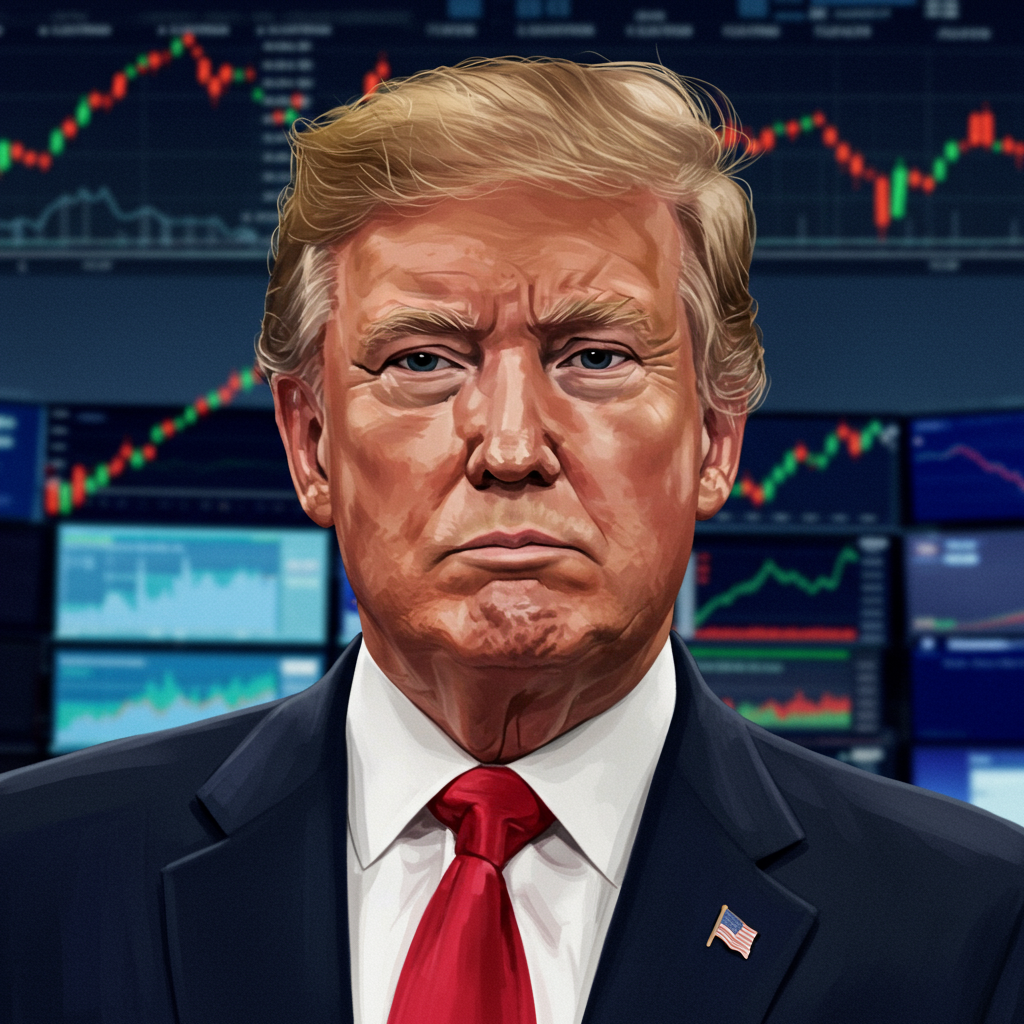president trump has once again launched a fierce attack on Federal Reserve Chair Jerome H. powell, openly stating he wishes Mr. Powell would resign. This public call for departure marks the latest escalation in a long-running feud. The president’s frustration centers on Mr. Powell’s handling of U.S. interest rates. He believes the central bank is not cutting borrowing costs fast enough. Mr. Powell’s term is scheduled to end in May of the following year. The Fed chair has maintained that the central bank must remain patient. He cites uncertainty surrounding the economic outlook as the reason for this cautious approach.
Trump’s Renewed Assault on Fed Leadership
President Trump’s pressure on Jerome Powell intensified significantly on Friday, June 27, 2025. He called for Mr. Powell to step down from his position. The president has criticized Mr. Powell for weeks. He described the Fed chair using harsh terms. These included “a stubborn mule” and someone suffering from “Trump derangement syndrome.” Mr. Trump believes these supposed traits explain Mr. Powell’s refusal to lower interest rates immediately.
Speaking from the Oval Office, the president made his desire clear. “I’d love for him to resign if he wanted to,” he told reporters. Such public demands have become a consistent feature of Mr. Trump’s second term. He nominated Mr. Powell to lead the Fed during his first term. However, he has spent the past several weeks castigating him. The core complaint remains Mr. Powell’s pace regarding interest rate reductions.
Why Lower Interest Rates Matter to Trump
Mr. Trump has consistently favored low interest rates. These rates make it cheaper for businesses and consumers to borrow money. Lower borrowing costs can stimulate economic activity and fuel growth. He previously pressured Mr. Powell during his first presidency. He felt the Fed chair was too slow to lower rates back then.
The push for lower borrowing costs has taken on increased importance recently. The administration is advocating for a large, expensive tax-cut package. Financing this package requires the U.S. government to sell significant amounts of debt. This process becomes more costly when interest rates are high.
Current interest rates are elevated, sitting in a range of 4.25 to 4.5 percent. Mr. Trump argues that the government could save billions on debt servicing costs if the Fed lowered rates. He has called for an immediate reduction of as much as 2.5 percentage points. He reiterated his frustration on Friday. “We have a guy that’s just a stubborn mule and a stupid person,” the president stated. He added, “He is making a big mistake.” Servicing the national debt is more expensive, he claimed, “because we have a guy who’s suffering from Trump derangement syndrome.” He concluded, “He’s not good for our country.”
The Federal Reserve’s Stance and Independence
Jerome Powell has largely avoided direct confrontations with President Trump. Despite the criticism, he remains firm about completing his term, which runs through May of the next year. The structure of the Federal Reserve is designed to be independent of political pressure. This independence allows the central bank to make potentially unpopular decisions necessary to control inflation and manage the economy effectively.
Powell has asserted that the president cannot fire him simply for policy disagreements. He maintains that removal requires “cause.” This refers to some form of misconduct. Current Supreme Court precedent generally supports this view. However, reports indicate the White House has been willing to test this standard. They have reportedly fired board members at other independent agencies. Powell has acknowledged monitoring a relevant Supreme Court case. However, he expressed uncertainty if it would apply directly to the Fed Chair’s position.
Powell has also noted that lawmakers from both major parties typically defend the Fed’s independence in setting monetary policy. While there might be internal disagreements, Powell has characterized the situation by saying the Fed is “blessed with a large number of amply-compensated critics.”
Economic Crosscurrents: Rates, Inflation, and Tariffs
The dispute between Trump and Powell is deeply rooted in differing economic viewpoints and policy priorities. The Fed’s mandate is dual: control inflation and support maximum employment. This balance is particularly challenging in the current environment.
The Fed sharply raised interest rates in 2022 and 2023. This was done to combat high inflation. Inflation peaked at 9.1% in 2022. It has since dropped significantly, reaching 2.4% recently. This figure is close to the Fed’s 2% target. The Fed did cut rates three times late the previous year. However, Powell and other policymakers have held rates steady more recently. This pause stems from economic uncertainty.
A major point of contention cited by Powell is the potential impact of Mr. Trump’s trade policies. Proposed sweeping tariffs include a 10% tax on all imports. There is also a massive 145% levy on imports from China. Powell has specifically warned that these tariffs are “highly likely to generate at least a temporary rise in inflation.” He noted the high levels of Trump’s import taxes exceeded most forecasts. This could lead to “more persistent” inflationary effects. Consequently, Powell indicated the central bank is “well positioned to wait for greater clarity” before deciding on rate reductions. He suggested tariffs pose a “challenging” scenario. They could potentially slow the economy while simultaneously pushing up prices. This risk is akin to stagflation.
Disputed Data and Political Attacks
President Trump disputes Powell’s assessment regarding tariffs and inflation. He claimed in social media posts that Powell’s report was a “complete mess.” He asserts that “Oil prices are down, groceries (even eggs!) are down, and the USA is getting RICH ON TARIFFS.” Trump argues that recent economic data, such as an unexpected retreat in overall inflation partly due to falling energy prices, shows conditions are ripe for rate cuts. He also points to actions by other central banks. The European Central Bank, for instance, has reportedly prepared for its seventh rate cut. Trump argues this shows the Fed is falling behind international counterparts.
However, data from the Labor Department contradicts some of Trump’s claims about falling grocery prices. The latest inflation report shows grocery prices actually rose the previous month. Egg prices specifically jumped nearly 6% between February and March. This was attributed to lingering effects of bird flu. While wholesale egg prices did fall, this doesn’t immediately translate to consumer price drops. The Yale University’s Budget Lab has estimated the inflationary impact of tariffs. They suggested it’s equivalent to a $4,900 loss for an average U.S. household.
Mr. Trump has used increasingly harsh language in his criticism. He recently described Powell as “truly one of the dumbest, and most destructive, people in Government.” He claimed the Fed’s rate is “far too high.” Other Trump-aligned figures have echoed this criticism. Vice President JD Vance accused the Fed of “monetary malpractice.” Bill Pulte, director of the Federal Housing Finance Agency, has publicly called for Powell’s resignation. Pulte stated that as Chairman of Fannie Mae and Freddie Mac, he could attest Powell was “hurting the housing market by being Too Late to lower rates.”
The financial markets have reacted negatively to the escalating rhetoric. U.S. stocks experienced a significant downturn following recent criticism from Trump. The Dow Jones, S&P 500, and Nasdaq all saw sharp declines. This market turmoil indicates investor anxiety. It is driven by political challenges to the Fed’s independence. Uncertainty regarding future monetary policy in response to trade tensions also plays a role.
Frequently Asked Questions
Why does President Trump want Fed Chair Powell to resign?
President Trump publicly wants Jerome Powell to resign primarily because of the Federal Reserve’s interest rate policy. Trump believes current rates are “far too high” and that Powell is too slow to cut them. He argues lower rates are needed to stimulate economic growth, make it cheaper to finance government debt from tax cuts, and prevent a potential slowdown. He has called Powell “stubborn” and blamed him for increased costs on the national debt.
Can a U.S. President legally fire the Federal Reserve Chair?
The legal authority for a president to fire the Federal Reserve Chair is contentious. The Fed is designed to be independent. The law states the Chair can only be removed “for cause,” meaning due to misconduct, not for policy disagreements. Jerome Powell has stated he would not resign if asked and maintains his position is legally protected. While some administrations have challenged similar protections for heads of other independent agencies, the specific legal status of the Fed Chair has historically been viewed as requiring cause for removal.
How could the conflict between Trump and Powell affect the U.S. economy?
The dispute creates significant uncertainty, which financial markets dislike. Powell warns that Trump’s tariffs could cause “stagflation” – a difficult scenario with both slowing growth and rising inflation. If the Fed lowers rates as Trump wants, it risks worsening tariff-induced inflation. If it holds rates steady to fight inflation, it risks slowing the economy further. Political pressure challenging the Fed’s independence could also make it harder for the central bank to effectively navigate these complex economic challenges based solely on data.
Conclusion
The ongoing tension between President Trump and Federal Reserve Chair Jerome Powell represents a significant challenge to the central bank’s traditional independence. Trump’s repeated calls for Powell’s resignation and his harsh criticisms reflect a fundamental disagreement over monetary policy direction. While Trump prioritizes lower rates for economic stimulus and debt financing, Powell and the Fed leadership emphasize patience, citing potential inflationary risks, particularly those stemming from the administration’s tariff policies. This clash of perspectives, underscored by disputed economic data and political pressure, creates uncertainty for financial markets and highlights the complex economic tightrope the Fed must walk. With Powell’s term set to conclude in May, the future leadership and policy direction of the Federal Reserve remain subjects of intense political and economic speculation.
Word Count Check: 1094



